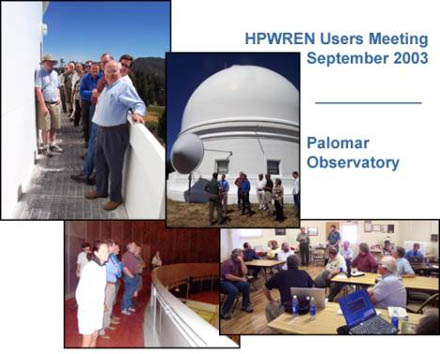News
HPWREN Users Meeting Focuses on Future of Network
Published October 14, 2003
The following news item was contributed by the High Performance Wireless Research and Education Network (HPWREN) project, a joint effort of SDSC and the Scripps Institution of Oceanography (both organized research units of the University of California, San Diego). HPWREN is creating, demonstrating, and evaluating a non-commercial prototype of a high-performance, wide-area wireless network in San Diego county. This NSF-funded network includes backbone nodes on the UC San Diego campus and a number of "hard to reach" areas in San Diego county; it not only is used for network analysis research, but also provides high-speed Internet access to field researchers from several disciplines (geophysics, astronomy, ecology) and educational opportunities for rural Native American learning centers and schools. See http://hpwren.ucsd.edu/ for more information.
On September 1, HPWREN collaborators met at the Palomar Observatory to discuss current and future network applications, funding issues, and network impacts.
Workshop speakers included NSF Project Manager Kevin Thompson, HPWREN PI Hans-Werner Braun, and HPWREN co-PI Frank Vernon. Other speakers included Duncan Agnew, Dan Cayan, Christopher Latham, John Orcutt, and Frieder Seible of the University of California, San Diego; Pablo Bryant, Paul Etzel, and Eric Frost of San Diego State University; Greg Aldering of the Lawrence Berkeley National Laboratory; Michael Peralta of the Tribal Digital Network; and Chris Hinshaw of the San Diego Sheriff's Department.

Richard Ellis of the California Institute of Technology, Director of the Palomar Observatory, welcomed the group for the meeting via a video-conference introduction. Several observatory staff attended as well, and the HPWREN team is grateful for their assistance with the meeting organization - especially Bob Thicksten.
The primary objective of this Second Annual HPWREN Meeting was to discuss the collaborations as well as the long-term continuity of the interdisciplinary network. Several presentations discussed how HPWREN allows multiple applications to utilize high performance networking that would not be feasible if each user community developed their own such network.
Presentation slides from the meeting are available at http://hpwren.ucsd.edu/2003_HPWREN_Users_Meeting/.
Photographs taken at the HPWREN Users Meeting are available at http://hpwren.ucsd.edu/Photos/20030911.
For more information about HPWREN activities and findings, please refer to HPWREN annual reports for 2001, 2002, and 2003.
- Kimberly Mann Bruch

